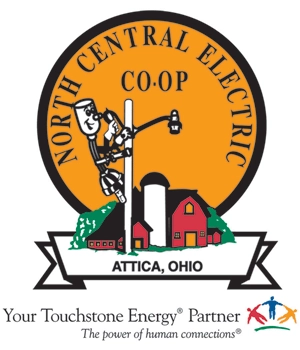Voluntary and Open Membership
Cooperatives are voluntary organizations, open to all persons able to use their services and willing to accept the responsibilities of membership, without gender, social, racial, political or religious discrimination.
Democratic Member Control
Cooperatives are democratic organizations controlled by their members, who actively participate in setting policies and making decisions. The elected representatives are accountable to the membership. In primary cooperatives, members have equal voting rights (one member, one vote) and cooperatives at other levels are organized in a democratic manner. Each year North Central Electric members elect at least three fellow members to the cooperative's board of trustees.
Members’ Economic Participation
Members contribute equitably to, and democratically control, the capital of their cooperative. At least part of that capital is usually the common property of the cooperative. Members usually receive limited compensation, if any, on capital subscribed as a condition of membership. Members allocate surpluses for any or all of the following purposes: developing the cooperative, possibly by setting up reserves, part of which at least would be indivisible; benefiting members in proportion to their transactions with the cooperative; and supporting other activities approved by the membership. Since 1980, North Central Electric has annually refunded patronage capital credits to members and former members.
Autonomy and Independence
Cooperatives are autonomous, self-help organizations controlled by their members. If they enter into agreements with other organizations, including governments, or raise capital from external sources, they do so on terms that ensure democratic control by their members and maintain their cooperative autonomy. In Ohio, the electric cooperatives autonomy is recognized by the legislature. Because members elect their own board of trustees to set rates and approve contracts, the Ohio electric cooperatives do not fall under the auspices of the Public Utilities Commission of Ohio (PUCO). The PUCO must approve the rates for Investor Owned Utilities like American Electric Power and FirstEnergy.
Energy Efficiency Tip
Be merry and bright, but don't let your holiday lights shine all night. Save money on your electric bill by installing a light timer for your decked-out home. It can help lower your electric bill and reduce energy consumption. Use a manual timer plugged into an electrical outlet to automatically turn lights on and off as scheduled.
Our History
Nationally
In the 1930's, electricity was a common luxury as long as you lived in the city. The power companies of these times were willing to provide power to cities, but taking their power and providing it to rural America with little or no profit for the companies was unrealistic; rural America was left in the dark.
Many of the conveniences available to American cities at the time was unknown to rural America. Wood and coal stoves were used to heat homes, water and food. Lighting for the family was often provided by kerosene lamps and candles. Everything from milking cows, pumping water and washing clothes was all done by hand.
In the city, laborsaving devices were greatly improving the quality of life. Because there was no electric service to those living in rural areas, electricity was becoming the great divide among those living in the city and those in rural areas.
Farmers wanted electricity, however privately owned power companies said serving rural areas would be too costly due to the homesteads being so far apart. They also believed that farmers would not use much electricity. With no profits to be made, rural America remained without electricity until the late 1930's.
Under President Franklin D. Roosevelt, the Rural Electrification Administration (REA) was formed. The 1935 administration was formed to administer a program to encourage rural electrification by lending low-interest money to any group or company that would undertake the task. Even with the offer of low-interest financing, almost all the private electric companies chose not to get involved.
Due to the low interest of private companies, farmers took it upon themselves to get their own electricity and decided to form cooperatives to do the job themselves.
Locally
On April 13, 1936, a group of Rural Electrification Association Committeemen from Hancock, Seneca, Wood and Wyandot counties met in Upper Sandusky, OH. Upon a motion made by Mr. Lewis Baldosser and a second by Mr. Paul O. Crum, the group voted to incorporate. Mr. L.B. Keller moved and Mr. Glenn Diller seconded that the name of the association be the North Central Farm Bureau Electric Cooperative -- now known as North Central Electric Cooperative. The motion passed unanimously.
Construction began in August 1937 and the first few miles of line were energized in March 1938. These few miles of line were able to provide electricity to a handful of member-owners. Since then, the cooperative has grown and its membership has become quite diverse.
In January 1998, North Central Electric formed a cooperative shared services and management federation with Lorain-Medina Rural Electric Cooperative of Wellington, OH. Under the federation, the cooperatives share corporate management staffs, accounting, billing, engineering, purchasing and marketing departments. Both cooperative's maintain separate offices and separate line crews.



 Member
Member